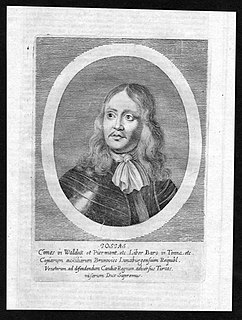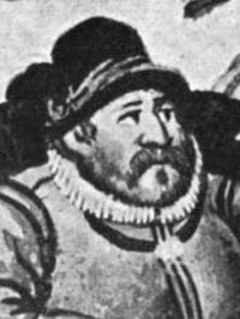The principality, or county of Waldeck-Eisenberg was a principality in the Holy Roman Empire that belonged to the Upper Rhenish Circle.
The principality, or county of Waldeck-Eisenberg was a principality in the Holy Roman Empire that belonged to the Upper Rhenish Circle.
The principality of Waldeck-Eisenberg was created In 1507 when the principality of Waldeck was divided between Count Henry VIII and his uncle Philip II. Philip acquired Eisenberg, Mengeringhausen, Landau and the half of Rhoden, Wettenberg and Waldeck. He also received a share of the herrschaft Itter. Korback was jointly ruled.
In 1538, Count Philip III divided the country among his two sons Wolrad II and John I. Wolrad was bestowed Eisenberg and John I got Landau.
Following the extinction of Waldeck-Landau in 1597 and Waldeck-Wildungen in 1598 Waldeck was reunited under the joint administration of the brothers Christian and Wolrad IV of Waldeck-Eisenberg.
In 1607, Waldeck was divided again. Wolrad IV got Eisenberg and Christian got Wildungen thus the branches Eisenberg and Wildungen were once again created
In 1625, the county of Bad Pyrmont was inherited from the estate of the county Gleichen. Out of the same estate also came the hereditary herrschaft Tonna in Thuringia. This herrschaft was obtained in 1640 of Schenk of Tautenburg. In 1677, the herrschaft Tonna was sold to the Duchy of Saxe-Gotha.
As a result of the marriage of Count Wolrad IV and Anna of Baden-Durlach in 1639 the earldom of Culemborg, the imperial county Wittem and the heerlijkheid Werth were inherited.
On June 1, 1682, Count Georg Friedrich was elevated to Prince of the Holy Roman Empire. Because he had no sons, with his death came an end to his regal title. His daughter Henriette inherited the earldom of Culemborg and the heerlijkheid Werth. Her sister Elizabeth Albertine inherited Wittem. Waldeck-Eisenberg reverted to Waldeck-Wildungen and thus reuniting Waldeck forever.

The County of Waldeck was a state of the Holy Roman Empire and its successors from the late 12th century until 1929. In 1349 the county gained Imperial immediacy and in 1712 was raised to the rank of Principality. After the dissolution of the Holy Roman Empire in 1806 it was a constituent state of its successors: the Confederation of the Rhine, the German Confederation, the North German Confederation, the German Empire and, until 1929, the Weimar Republic. It comprised territories in present-day Hesse and Lower Saxony (Germany).
Waldeck may refer to:

Prince Georg Friedrich of Waldeck was a German and Dutch Field Marshal and, for the last three years of his life, Grand Master of the Order of Saint John.
Count Wolrad I of Waldeck was a son of Count Henry VII of Waldeck and his wife Margaret of Nassau-Wiesbaden-Idstein. He was named after his maternal grandfather, and was the first Wolrad in the House of Waldeck. He succeeded his father as the reigning Count of Waldeck-Waldeck in 1442 – whether this was before or after his father's death is still unclear. The House Waldeck had been split since 1397 into the senior Waldeck-Landau line and the junior Waldeck-Waldeck line.
Count Philip IV of Waldeck was Count of Waldeck-Wildungen from 1513 to 1574. In 1526, he and his uncle Philip III of Waldeck-Eisenberg led the Lutheran Reformation in the county of Waldeck.

Count Christian Louis of Waldeck was from 1645 Count of Waldeck-Wildungen and from 1692 Count of Waldeck and Pyrmont.
Philip III, Count of Waldeck, was from 1524 to 1539 Count of Waldeck-Eisenberg.
Henry VIII (1465–1513) was a count of Waldeck and the founder of the older line of Waldeck-Wildungen. He was also temporarily governor of the County of Vianden, a possession of the House of Nassau.

Count Wolrad II ‘the Scholar’ of Waldeck-Eisenberg, German: Wolrad II. ‘der Gelehrte’ Graf von Waldeck-Eisenberg, was since 1539 Count of Waldeck-Eisenberg.

Count Philip VII of Waldeck-Wildungen, German: Philip VII. Graf von Waldeck-Wildungen, official titles: Graf zu Waldeck und Pyrmont, Herr zu Tonna, was since 1638 Count of Waldeck-Wildungen.
Count Philip II of Waldeck-Eisenberg was count of Waldeck-Eisenberg. His parents were Count Wolrad I of Waldeck and Barbara of Wertheim.

Count Wolrad IV ‘the Pious’ of Waldeck-Eisenberg, German: Wolrad IV. ‘der Fromme’ Graf von Waldeck-Eisenberg, official titles: Graf zu Waldeck und Pyrmont, was since 1588 Count of Waldeck-Eisenberg. He founded of the new line of Waldeck-Eisenberg.

Count Christian of Waldeck-Wildungen, German: Christian Graf von Waldeck-Wildungen, official titles: Graf zu Waldeck und Pyrmont, was since 1588 Count of Waldeck-Eisenberg and after the division with his brother in 1607 Count of Waldeck-Wildungen. He founded the new cadet branch of Waldeck-Wildungen and is the progenitor of the princes of Waldeck and Pyrmont.
Otto IV, Count of Waldeck at Landau was the third and last ruling count of the elder Waldeck-Landau line. He was the grandson of Count Adolph III, who had founded the elder Waldeck-Landau line in 1387 and was the third and only surviving son of Count Otto III and his wife Anna of Oldenburg. His elder brothers John and Henry had died unmarried and childless in 1431 and 1438 respectively.

Count Josias I of Waldeck-Eisenberg, German: Josias I. Graf von Waldeck-Eisenberg, was since 1578 Count of Waldeck-Eisenberg.
Henry Wolrad, Count of Waldeck was from 1645 Count of Waldeck-Eisenberg and Lord of Culemborg.

Count Josias II of Waldeck-Wildungen, German: Josias II. Graf von Waldeck-Wildungen, official titles: Graf zu Waldeck und Pyrmont, Herr zu Tonna, was since 1660 Count of Waldeck-Wildungen. However, he was primarily a military man.

Count John I ‘the Pious’ of Waldeck-Landau, German: Johann I. ‘der Fromme’ Graf von Waldeck-Landau, was since 1539 Count of Waldeck-Landau. He was the founder of the younger cadet branch of Waldeck-Landau.

Philip Dietrich, was the ruling Count of Waldeck-Eisenberg from 1640 until his death.

Count John II of Waldeck-Landau, German: Johann II. Graf von Waldeck-Landau, official titles: Graf zu Waldeck und Pyrmont, Herr zu Tonna, was since 1638 Count of Waldeck-Landau. He served in the Swedish Army.